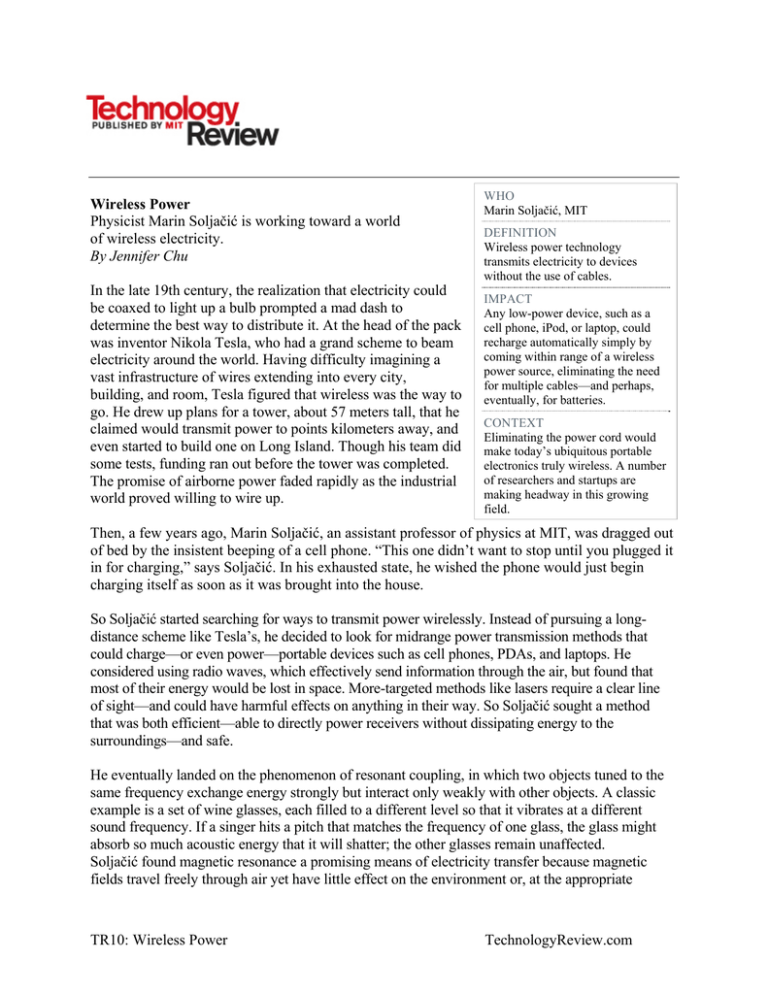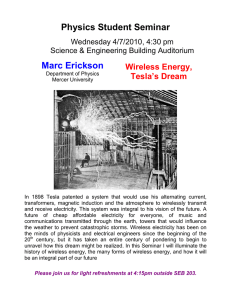
NSORS
Wireless Power
Physicist Marin Soljačić is working toward a world
of wireless electricity.
By Jennifer Chu
In the late 19th century, the realization that electricity could
be coaxed to light up a bulb prompted a mad dash to
determine the best way to distribute it. At the head of the pack
was inventor Nikola Tesla, who had a grand scheme to beam
electricity around the world. Having difficulty imagining a
vast infrastructure of wires extending into every city,
building, and room, Tesla figured that wireless was the way to
go. He drew up plans for a tower, about 57 meters tall, that he
claimed would transmit power to points kilometers away, and
even started to build one on Long Island. Though his team did
some tests, funding ran out before the tower was completed.
The promise of airborne power faded rapidly as the industrial
world proved willing to wire up.
WHO
Marin Soljačić, MIT
DEFINITION
Wireless power technology
transmits electricity to devices
without the use of cables.
IMPACT
Any low-power device, such as a
cell phone, iPod, or laptop, could
recharge automatically simply by
coming within range of a wireless
power source, eliminating the need
for multiple cables—and perhaps,
eventually, for batteries.
CONTEXT
Eliminating the power cord would
make today’s ubiquitous portable
electronics truly wireless. A number
of researchers and startups are
making headway in this growing
field.
Then, a few years ago, Marin Soljačić, an assistant professor of physics at MIT, was dragged out
of bed by the insistent beeping of a cell phone. “This one didn’t want to stop until you plugged it
in for charging,” says Soljačić. In his exhausted state, he wished the phone would just begin
charging itself as soon as it was brought into the house.
So Soljačić started searching for ways to transmit power wirelessly. Instead of pursuing a longdistance scheme like Tesla’s, he decided to look for midrange power transmission methods that
could charge—or even power—portable devices such as cell phones, PDAs, and laptops. He
considered using radio waves, which effectively send information through the air, but found that
most of their energy would be lost in space. More-targeted methods like lasers require a clear line
of sight—and could have harmful effects on anything in their way. So Soljačić sought a method
that was both efficient—able to directly power receivers without dissipating energy to the
surroundings—and safe.
He eventually landed on the phenomenon of resonant coupling, in which two objects tuned to the
same frequency exchange energy strongly but interact only weakly with other objects. A classic
example is a set of wine glasses, each filled to a different level so that it vibrates at a different
sound frequency. If a singer hits a pitch that matches the frequency of one glass, the glass might
absorb so much acoustic energy that it will shatter; the other glasses remain unaffected.
Soljačić found magnetic resonance a promising means of electricity transfer because magnetic
fields travel freely through air yet have little effect on the environment or, at the appropriate
TR10: Wireless Power
TechnologyReview.com
frequencies, on living beings. Working with MIT physics professors John Joannopoulos and Peter
Fisher and three students, he devised a simple setup that wirelessly powered a 60-watt light bulb.
The researchers built two resonant copper coils and hung them from the ceiling, about two meters
apart. When they plugged one coil into the wall, alternating current flowed through it, creating a
magnetic field. The second coil, tuned to the same frequency and hooked to a light bulb, resonated
with the magnetic field, generating an electric current that lit up the bulb—even with a thin wall
between the coils.
So far, the most effective setup consists of 60-centimeter copper coils and a 10-megahertz
magnetic field; this transfers power over a distance of two meters with about 50 percent efficiency.
The team is looking at silver and other materials to decrease coil size and boost efficiency. “While
ideally it would be nice to have efficiencies at 100 percent, realistically, 70 to 80 percent could be
possible for a typical application,” says Soljačić.
Other means of recharging batteries without cords are emerging. Startups such as Powercast,
Fulton Innovation, and WildCharge have begun marketing adapters and pads that allow consumers
to wirelessly recharge cell phones, MP3 players, and other devices at home or, in some cases, in
the car. But Soljačić’s technique differs from these approaches in that it might one day enable
devices to recharge automatically, without the use of pads, whenever they come within range of a
wireless transmitter.
The MIT work has attracted the attention of consumer-electronics companies and the auto industry.
The U.S. Department of Defense, which is funding the research, hopes it will also give soldiers a
way to automatically recharge batteries. However, Soljačić remains tight-lipped about possible
industry collaborations.
“In today’s battery-operated world, there are so many potential applications where this might be
useful,” he says. “It’s a powerful concept.”
Copyright © 2008, Technology Review Inc. All Rights Reserved.
http://www.technologyreview.com
TR10: Wireless Power
TechnologyReview.com


